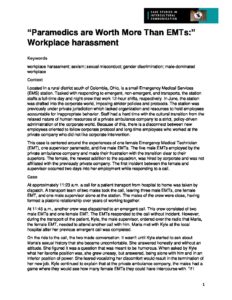“Paramedics are Worth More Than EMTs:” Workplace harassment
Keywords
workplace harassment; sexism; sexual misconduct; gender discrimination; male-dominated workplace
Context
Located in a rural district south of Colombia, Ohio, is a small Emergency Medical Services (EMS) station. Tasked with responding to emergent, non-emergent, and transports, the station staffs a full-time day and night crew that work 12-hour shifts, respectively. In June, the station was drafted into the corporate world, imposing stricter policies and protocols. The station was previously under private jurisdiction which lacked organization and resources to hold employees accountable for inappropriate behavior. Staff had a hard time with the cultural transition from the relaxed nature of human resources of a private ambulance company to a strict, policy-driven administration of the corporate world. Because of this, there is a disconnect between new employees oriented to follow corporate protocol and long-time employees who worked at the private company who did not like corporate intervention.
This case is centered around the experiences of one female Emergency Medical Technician (EMT), one supervisor paramedic, and five male EMTs. The five male EMTs are employed by the private ambulance company and made their frustration with the transition clear to their superiors. The female, the newest addition to the squadron, was hired by corporate and was not affiliated with the previously private company. The first incident between the female and supervisor occurred two days into her employment while responding to a call.
Case
At approximately 11:23 a.m. a call for a patient transport from hospital to home was taken by dispatch. A transport team of two males took the call, leaving three male EMTs, one female EMT, and one male supervisor alone at the station. The males of the crew were close, having formed a platonic relationship over years of working together.
At 11:45 a.m., another crew was dispatched to an emergent call. This crew consisted of two male EMTs and one female EMT. The EMTs responded to the call without incident. However, during the transport of the patient, Kyle, the male supervisor, ordered over the radio that Maria, the female EMT, needed to attend another call with him. Maria met with Kyle at the local hospital after her previous emergent call was completed.
On the ride to the call, the two made conversation. It wasn’t until Kyle started to ask about Maria’s sexual history that she became uncomfortable. She answered honestly and without an attitude. She figured it was a question that was meant to be humorous. When asked by Kyle what her favorite position was, she grew uneasy, but answered, being alone with him and in an inferior position of power. She feared vocalizing her discomfort would result in the termination of her new job. Kyle continued to explain that at the private ambulance company, the males had a game where they would see how many female EMTs they could have intercourse with. “If I weren’t married,” he said, “you’d be on my list. Everyone at the station already said they want to do you.”
Maria remained silent for the rest of the call. She thought about going to Human Resources, but upon arriving back at the station, she’d learned that the male EMTs had started making bets on who she would have a sexual relationship with first. It became apparent that she was the only female at the station at the moment and anything she said would be seen as a lie.
“You have to be careful these days,” a male EMT said during lunch. “Women make accusations all the time.”
Maria did not go to Human Resources that day. The next day, she called a female supervisor and explained what happened. The female supervisor said that she would take it to Human Resources, but not to expect anything substantial to happen. “It’s a boys club, Maria. And paramedics are worth more than EMTs. Sorry, hon.”
Discussion Questions
As you consider this case, discuss:
- What issues are present in this case?
- What cultures and identities are salient in this scenario?
- How could communication and connection be improved between supervisors and EMTs?
- How would you have handled the situation if you were Maria?
- What steps could her employer take to mediate the situation?
- What intercultural activities or training could help improve the work environment at the station?
- Why do you think Maria would be hesitant to report?
- What are the established power dynamics in this case?
Additional Resources
Additional recommended resources to explore the central themes in this case are available.
Journal of Emergency Medical Services. (January 17, 2018). “#Metoo: Sexual Harassment in Ems.” https://www.jems.com/ems-insider/metoo-sexual-harassment-in-the-ems-workplace/
Mihajlovska, A. (March 15, 2021). “How To Survive And Thrive In A Male-Dominated Workplace.” https://www.forbes.com/sites/ellevate/2021/03/15/how-to-survive-and-thrive-in-a-male-dominated-workplace/?sh=46a4e5a87d1b
Parker, K. (March 7, 2018). “Women in majority-male workplaces report higher rates of gender discrimination.” https://www.pewresearch.org/fact-tank/2018/03/07/women-in-majority-male-workplaces-report-higher-rates-of-gender-discrimination/r
Corresponding Author
Mack, Julianna. American University, Washington, D.C., USA. Email: jm5821a@student.american.edu


